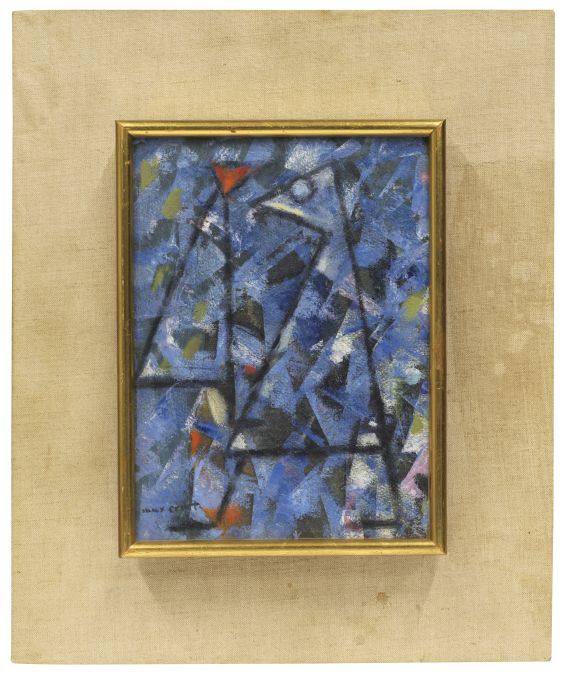Cornice
475
Max Ernst
Promenade sous la neige, 1957.
Oil on paper on canvas, on canvas-covered cardb...
Stima:
€ 60,000 / $ 69,600 Risultato:
€ 95,250 / $ 110,489 ( commissione inclusa)
Promenade sous la neige. 1957.
Oil on paper on canvas, on canvas-covered cardboard.
Signed in lower left. Titled and inscribed with a dedication on the reverse. 24.4 x 18 cm (9.6 x 7 in), the full sheet.
• Max Ernst had significant influence on Dada and Surrealism.
• Since his 'Histoire naturelle' (1926), the surreal elements of nature have been one of the most important themes in his oeuvre.
• Max Ernst participated in documenta I, II, III.
• As a central artist of the German-French avant-garde, Max Ernst's works are at, among others, the Solomon R. Guggenheim Museum, Metropolitan Museum and Museum of Modern Art, New York, the Center Pompidou, Paris, and Tate Gallery, London.
Accompanied by a confirmation of authenticity issued by Dr. Jürgen Pech, Bonn, from October 29, 2023. The present work is documented in the archive of the oeuvre catalog Max Ernst.
PROVENANCE: Max Ernst, Huismes (France).
Collection of Madame Floquet, Annecy (gift from the artist).
Private collection (acquired from Hôtel Marcel Dassault, December 15, 2000, lot 12).
Private collection Switzerland (acquired from the above, Christie's June 19, 2007, lot 468).
Private collection Switzerland (acquired from the above).
LITERATURE: Hôtel Marcel Dassault, Paris, Auction Art Moderne, December 15, 2000, lot 12 (color illu.).
Christie’s, London, Impressionist and Modern Art Day Sale, June 19, 2007 (color illu.).
Oil on paper on canvas, on canvas-covered cardboard.
Signed in lower left. Titled and inscribed with a dedication on the reverse. 24.4 x 18 cm (9.6 x 7 in), the full sheet.
• Max Ernst had significant influence on Dada and Surrealism.
• Since his 'Histoire naturelle' (1926), the surreal elements of nature have been one of the most important themes in his oeuvre.
• Max Ernst participated in documenta I, II, III.
• As a central artist of the German-French avant-garde, Max Ernst's works are at, among others, the Solomon R. Guggenheim Museum, Metropolitan Museum and Museum of Modern Art, New York, the Center Pompidou, Paris, and Tate Gallery, London.
Accompanied by a confirmation of authenticity issued by Dr. Jürgen Pech, Bonn, from October 29, 2023. The present work is documented in the archive of the oeuvre catalog Max Ernst.
PROVENANCE: Max Ernst, Huismes (France).
Collection of Madame Floquet, Annecy (gift from the artist).
Private collection (acquired from Hôtel Marcel Dassault, December 15, 2000, lot 12).
Private collection Switzerland (acquired from the above, Christie's June 19, 2007, lot 468).
Private collection Switzerland (acquired from the above).
LITERATURE: Hôtel Marcel Dassault, Paris, Auction Art Moderne, December 15, 2000, lot 12 (color illu.).
Christie’s, London, Impressionist and Modern Art Day Sale, June 19, 2007 (color illu.).
For Max Ernst, nature was an essential source of inspiration through which he was able to express his intuitions and surreal imaginations. With "Promenade sou la neige" he puts us in a quasi-hallucinatory state: the sound of footsteps crunching the snow and the muted perception of the surrounding become palpable.
In his 'Histoire naturelle' (1926), Max Ernst made the surreal elements of nature one of the most important themes in his oeuvre. Paintings such as "la Nymphe Écho" (1936) at the MoMA, New York, "La dernière forêt" (1960/70) at the Center Pompidou, Paris, or (La nature à l'aurore) (1936) at the Städel Museum in Frankfurt am Main, provide impressive proof thereof.
Max Ernst uses his art to restore surprise, irritation and mystery to nature, contrary to its disenchantment through science and the consumer culture. Recently, the Kunstmuseum Bonn dedicated the exhibition "Max Ernst und die Natur als Erfindung” (Max Ernst and Nature as Invention, October 13, 2022 - January 22, 2023) to this topic. The exhibition examined the artist's work as a draft of an alternative natural history in the context of the art of his time up to the present day. Hence “Promenade sous la neige” is a work that addresses an elementary theme in Max Ernst’s world of thought. It is particularly worthwhile mentioning that the canvas-covered cardboard onto which the small picture is mounted, was selected, designed and inscribed with a personal dedication for the first owner by Max Ernst. [EH]
In his 'Histoire naturelle' (1926), Max Ernst made the surreal elements of nature one of the most important themes in his oeuvre. Paintings such as "la Nymphe Écho" (1936) at the MoMA, New York, "La dernière forêt" (1960/70) at the Center Pompidou, Paris, or (La nature à l'aurore) (1936) at the Städel Museum in Frankfurt am Main, provide impressive proof thereof.
Max Ernst uses his art to restore surprise, irritation and mystery to nature, contrary to its disenchantment through science and the consumer culture. Recently, the Kunstmuseum Bonn dedicated the exhibition "Max Ernst und die Natur als Erfindung” (Max Ernst and Nature as Invention, October 13, 2022 - January 22, 2023) to this topic. The exhibition examined the artist's work as a draft of an alternative natural history in the context of the art of his time up to the present day. Hence “Promenade sous la neige” is a work that addresses an elementary theme in Max Ernst’s world of thought. It is particularly worthwhile mentioning that the canvas-covered cardboard onto which the small picture is mounted, was selected, designed and inscribed with a personal dedication for the first owner by Max Ernst. [EH]
475
Max Ernst
Promenade sous la neige, 1957.
Oil on paper on canvas, on canvas-covered cardb...
Stima:
€ 60,000 / $ 69,600 Risultato:
€ 95,250 / $ 110,489 ( commissione inclusa)




 Lot 475
Lot 475 